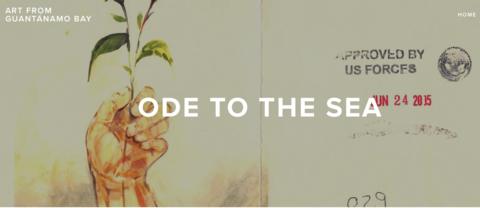Ex-Guantánamo Prisoner Discusses Prison Artwork with the BBC, While Lawyers for “High-Value Detainee” Demand His Right to Continue Making Art

The header from 'Ode to the Sea: Art from Guantánamo Bay,' the exhibition that ran in New York from October 2017 to January 2018.
If you can, please make a donation to support our work in 2018. If you can become a monthly sustainer, that will be particularly appreciated. Tick the box marked, "Make this a monthly donation," and insert the amount you wish to donate.
By Andy Worthington, April 20, 2018
Last October, an exhibition opened in the President's Gallery, in John Jay College of Criminal Justice in New York, that might have attracted little attention had the Pentagon not decided to make a big song and dance about it.
The exhibition, 'Ode to the Sea: Art from Guantánamo Bay,' featured artwork by eight former and current Guantánamo prisoners — four freed, and four still held — which was given by the prisoners to their lawyers and their families, and it was not until November that the Pentagon got upset, apparently because the promotional material for the exhibition provided an email address for anyone "interested in purchasing art from these artists." The obvious conclusion should have been that "these artists" meant the released prisoners, who should be free to do what they want with their own artwork, but the Pentagon didn’t see it that way.
On November 15, as I explained in my first article about the controversy, a spokesman, Air Force Maj. Ben Sakrisson, said that "all Guantánamo detainee art is 'property of the US government' and 'questions remain on where the money for the sales was going,'" while, at the prison itself, Navy Cmdr. Anne Leanos said in a statement that "transfers of detainee made artwork have been suspended pending a policy review."
Ramzi Kassem, a professor at CUNY School of Law, whose legal clinic represents Guantánamo prisoners, said that one particular prisoner was told "art would not be allowed out of the prison," and added that, if any prisoner were to be allowed to leave Guantánamo (which, crucially, has not happened under Donald Trump), "their art would not even be allowed out with them and would be incinerated instead."
I subsequently followed up on the story, as Erin Thompson, a professor of art crime and one of the curators of the show, responded robustly. In a powerful op-ed in the New York Times, which I cross-posted here, with my own commentary, she stated, "Art censorship and destruction are tactics fit for terrorist regimes, not for the U.S. military. The art poses no security threat: It is screened by experts who study the material for secret messages before it leaves the camp, and no art by current prisoners can be sold. Guantánamo detainees deserve basic human rights as they await trial. Taking away ownership of their art is both incredibly petty and utterly cruel."
Erin Thompson then wrote another article for Tom Dispatch, which I cross-posted here, and I also cross-posted a Washington Post op-ed by former prisoner (and best-selling author) Mohamedou Ould Slahi, and in January, on my annual visit to call for the closure of Guantánamo on the anniversary of its opening, I visited the exhibition myself, just before it closed, an inspiring occasion that I wrote about in an article entitled, Reviewing the Guantánamo Art Show in New York That Dared to Show Prisoners As Human Beings, and Led to a Pentagon Clampdown.
As I stated:
The show was powerful, but in a genuinely understated way. Some of the prisoners showed a real artistic talent; others less so. Of particular note was the work by Mohammed al-Ansi (aka Muhammad Ansi) and Djamel Ameziane, both released, and the elaborate sculptures of ships made of discarded materials by "forever prisoner" Moath al-Alwi, a Yemeni still held not because he has ever been accused of any significant involvement with terrorism, but because he has been a long-term hunger striker, and is not regarded as having been sufficiently cooperative. In a similar position is Khalid Qassim, who has produced interesting paintings through a variety of media.
Above all, however, the prisoners’ work, generally featuring uncontentious subject matter, did nothing more shocking than daring to show that they are human beings.
Recently, an extremely powerful program about the prisoners’ art was broadcast by BBC Radio 4, and is still available on iPlayer, featuring, in particular, former prisoner Mansoor Adayfi, a Yemeni who was resettled in Serbia in 2016, and who wrote a truly inspiring article about the significance of the sea for the prisoners, which was published by the New York Times in September (taken from the exhibition catalog), and which I cross-posted here.
As the introducton to the show on the BBC’s website states, Mansoor Adayfi "guides us vividly" through the exhibit. He "takes us behind the headlines and tells the story of his years at Guantánamo through the lens of art — the insight it gives us into the detainees' lives and captivity and their imaginations."
The show also features contributions from Erin Thompson, Alka Pradhan, a defense attorney in the military commissions, and the painter Gail Rothschild.
More recently, Alka Pradhan submitted a motion to those responsible for the military commissions, calling for her client Ammar al-Baluchi, the only "high-value detainee" whose work featured in the exhibition, to continue to be allowed to make art and to make it available to his lawyers and his family. His piece, "Vertigo at Guantanamo," described by the website artnet as "a series of multicolored dots in a pattern that evokes a tornado," drew on his experiences of torture in a CIA "black site."
As Alka Pradhan said in an email to artnet, "Both the creation and public dissemination of Mr. Al-Baluchi’s artwork has become incredibly important for his mental health; both in terms of mitigation value in his death penalty case, and for the therapeutic value to alleviate the effects of his torture." She added, as artnet put it, that his artwork "could make him seem more sympathetic when it comes time to sentencing at the military tribunal."
Since the Pentagon’s clampdown, artnet noted, al-Baluchi has not had "access to art supplies to make new work," describing this as "a situation Pradhan hopes to rectify in the coming weeks," and also explaining that he "has been forced to turn down numerous requests to exhibit his work since the New York art show." I understand that other prisoners — the boat-maker Moath al-Alwi, for example, who made his boats relentlessly — have also had their artistic activities curtailed, even though there is nothing contentious about their work, and it is beneficial for their mental health, something that prisoners are allowed to have in the federal prison system, and as they clearly should at Guantanamo too.




